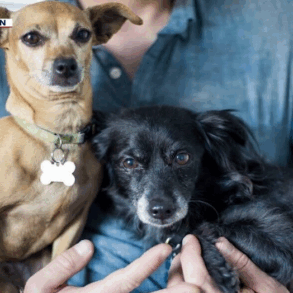
If you have ever talked to your dog, looked into their eyes, and saw understanding, you may not be just a hopelessly devoted pet owner. Indeed, most of us humans wonder whether our dogs actually understand what they’re saying when we talk to them.
Offering an exciting glimpse into this very inquiry, a fascinating study led by the University of Geneva and the Hearing Institute reveals how dogs and their human counterparts break down interspecies communication barriers when people talk to their dogs.
Humans talking to dogs
First off, let’s acknowledge the elephant in the room or, in this case, the dog. Do you change your voice when speaking to your beloved canine?
A seemingly whimsical trait, this turns out to be an instrumental facet in interspecies communication, particularly humans talk to their dogs.
According to Eloïse Déaux, a researcher in animal behavior and neurosciences, this voice modulation helps bridge the gap between the distinct speech rates of dogs and humans.
In layman’s terms, when addressing our dogs, we slow down our speech to replicate their typical speech rate.
“Humans slow down their speech when addressing their pets; it’s a modification that brings them closer to the dog’s typical speech rate and could facilitate understanding,” explains Eloïse Déaux.
But why is there a difference at all?
Well, this boils down to not only anatomic differences but also intricate brain mechanisms, specifically neural oscillations, the electrical patterns in the brain resulting from neurons’ synchronous activity.
Dog brain waves
Brain waves or neural oscillations are categorized by their frequency. While delta waves operate between 0.5 and 4 Hertz (Hz), theta waves snag a frequency between 4 and 7 Hz.
Each frequency band plays a unique role in cognitive mechanisms. For instance, in human language comprehension, gamma waves code phonemes, theta waves handle syllabification, and delta waves deal with intonation.
Anne-Lise Giraud, a neuroscience professor and the project’s driving force, explains that applying the study of brain oscillations to dogs is truly groundbreaking.
The research team adapted non-invasive electroencephalography (EEG) protocols to study the brain waves of canines and humans in response to auditory stimuli.
Shockingly enough, while the theta waves in humans correlate with the acoustic envelope, in dogs, it’s the seemingly sluggish delta waves that take the cake.
But how does this help us understand what Fido is thinking?
Lost in translation
Humans can easily report their comprehension of a sound stimulus in either spoken or written form. But when it comes to dogs, it’s a whole different ballgame.
The researchers used dog-directed speech consisting of commands, allowing them to measure the stimulus’s intelligibility for the dog via its execution of the various commands.
Through this novel approach, the researchers modulated the recorded sentences to slow down or speed up their rate.
“To get the content-free condition, for example, we reverse the recording of the master’s command. So ‘sit’ becomes something like ‘tis’. We then reverse back the prosody to match that of the original signal,” Eloïse Déaux describes the method.
Dogs understanding humans when they talk
The researchers found that dogs fail to respond to commands spoken too quickly. They can process human language but only if it’s in the delta band, between 1 and 3 Hz.
The loss of content also influences comprehension. With prosody alone, command intelligibility drops significantly.
This study busts the myth that dogs only care about our intonation. Phonological content, it seems, plays a crucial role, although, unlike us, syllables aren’t dogs’ primary comprehension tools.
Moreover, the results illustrate a deep connection between comprehension and oscillations. The more the theta waves in humans and delta waves in dogs align with the signal’s envelope, the higher the comprehension.
Man’s best friend or fluke?
This study by University of Geneva proposes that dogs and humans have coadapted to effectively communicate with one another.
But is this exclusively a dog-human dynamic? Would other domesticated animals display this same adaptive communication?
An interesting avenue for future research, the study suggests comparing this phenomenon with other non-domesticated canids like wolves to distinguish which linguistic abilities in dogs are innate and which are socially conditioned.
“A better understanding of the dog’s cerebral mechanisms will enable us to gain knowledge about humans and our evolution, as this animal is evolutionarily very distant from us, but also to improve training techniques for our four-legged friends,” Eloïse Déaux concludes.
Next time you chat with your puppy pal, remember, there’s more going on than just wagging tails and wet noses.
Whether your discourse is about a walk in the park or a treat for good behavior, know that you’re engaging in a communication style thousands of years in the making. Now that’s nothing to bark at!
The study is published in the journal PLoS Biology.
—–
Like what you read? Subscribe to our newsletter for engaging articles, exclusive content, and the latest updates.
Check us out on EarthSnap, a free app brought to you by Eric Ralls and Earth.com.
—–
This post was originally published on this site be sure to check out more of their content.













































